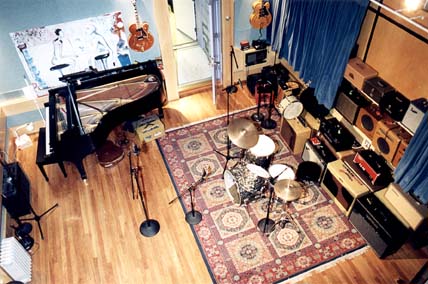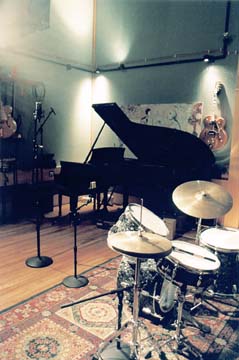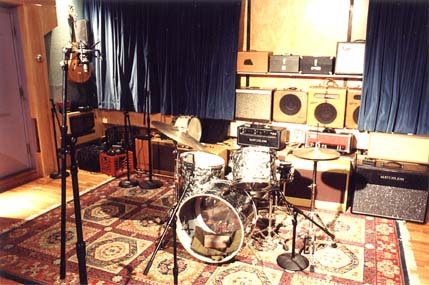
The Story Of Rear Window
 Structure: Rear Window Recording Studio was built in 1995 as an addition onto a one hundred year old house in the Boston area. The 19X21 ft. live room is an entirely new structure, whose floor is ten feet below ground level to allow for a 20 foot ceiling, which is suspended by 150 springs and weighs 10,000 lbs. The floor and walls also float on elastic media, and the overall effect is that the room "breathes", handling transients in a natural and forgiving way, allowing for liveliness without harshness. The studio has been featured in Drum magazine as one of New England's premiere drum rooms. A heavy, theatrical grade velvet curtain lines one entire wall for variable acoustics.
Structure: Rear Window Recording Studio was built in 1995 as an addition onto a one hundred year old house in the Boston area. The 19X21 ft. live room is an entirely new structure, whose floor is ten feet below ground level to allow for a 20 foot ceiling, which is suspended by 150 springs and weighs 10,000 lbs. The floor and walls also float on elastic media, and the overall effect is that the room "breathes", handling transients in a natural and forgiving way, allowing for liveliness without harshness. The studio has been featured in Drum magazine as one of New England's premiere drum rooms. A heavy, theatrical grade velvet curtain lines one entire wall for variable acoustics.
 Most of the spatial effects achieved on Four Piece Suit recordings derive from placement of ambient room mics, not from digital effects. Something for Cat and Strip Search from the Ready to Where? CD and Roxotica and Old Cape Cod from the Matinee Idylls CD are tracks where you can really "hear the room".
Most of the spatial effects achieved on Four Piece Suit recordings derive from placement of ambient room mics, not from digital effects. Something for Cat and Strip Search from the Ready to Where? CD and Roxotica and Old Cape Cod from the Matinee Idylls CD are tracks where you can really "hear the room".
Adjacent to the studio's live room, the main isolation booth has the full 20 ft. ceiling height, and with a 9X10 ft. floor, can accomodate a full drum kit. In terms of wall acoustic treatment, the booth is designed to be very live at the floor to 3 ft. high level, is diffused for an additional 3 feet above that, and then progressively dead , moving from the 6 foot level toward the ceiling, which is maximally dead. Microphones hang from a pulley system on the ceiling, which allows easy access to sample all the degrees of liveness at various levels.
 Also adjacent to the studio's live room, there is a 4X10 ft. iso booth with a 9 ft. ceiling, ideal for amps. A 6X7 ft. vocal booth is located on the studio's upper level, just off the control room, which is 12X18 ft. and was originally the kitchen and pantry of the old house. The control room window looks down upon the floor of the live room from a height of 10 feet, in an arrangement similar to Abbey Road Studio B. The window is actually at the rear of the control room (hence Rear Window ), which allows for optional visual contact between engineer and artist, depending on the artist's preference. The control room is diffused at the back wall, and dead from the mix position forward, with non parallel walls and angled ceiling.
Also adjacent to the studio's live room, there is a 4X10 ft. iso booth with a 9 ft. ceiling, ideal for amps. A 6X7 ft. vocal booth is located on the studio's upper level, just off the control room, which is 12X18 ft. and was originally the kitchen and pantry of the old house. The control room window looks down upon the floor of the live room from a height of 10 feet, in an arrangement similar to Abbey Road Studio B. The window is actually at the rear of the control room (hence Rear Window ), which allows for optional visual contact between engineer and artist, depending on the artist's preference. The control room is diffused at the back wall, and dead from the mix position forward, with non parallel walls and angled ceiling.
All rooms are interconnected by tie lines and speaker lines.
For More Info on Rear Window Recording Studio EMAIL US





